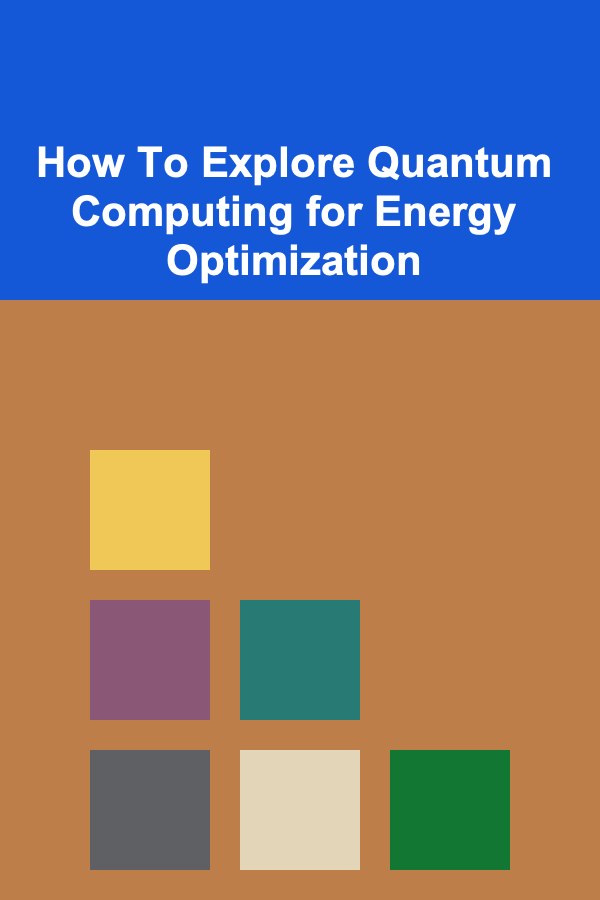
How To Explore Quantum Computing for Energy Optimization
ebook include PDF & Audio bundle (Micro Guide)
$12.99$9.99
Limited Time Offer! Order within the next:

Quantum computing has emerged as one of the most revolutionary technologies in the field of computational science, poised to redefine our approach to solving some of the most complex problems in various industries. One of the most exciting applications of quantum computing lies in energy optimization. From renewable energy systems to power grid management, quantum computing offers the potential to make energy systems more efficient, sustainable, and responsive to dynamic conditions. In this article, we will explore how quantum computing can be utilized to optimize energy systems, addressing the challenges, techniques, and future outlook for energy optimization in the quantum era.
The Basics of Quantum Computing
To understand how quantum computing can be applied to energy optimization, it's crucial first to grasp the basics of quantum mechanics and quantum computing.
Quantum Mechanics and Qubits
Quantum computing leverages the principles of quantum mechanics, the branch of physics that deals with phenomena at atomic and subatomic scales. Unlike classical computing, which uses bits to represent either a 0 or 1, quantum computing uses qubits (quantum bits). Qubits can represent both 0 and 1 simultaneously, thanks to a phenomenon known as superposition. This allows quantum computers to process information in parallel, exponentially increasing their computational power for certain types of problems.
Another crucial concept in quantum computing is entanglement, which describes the phenomenon where the state of one qubit is directly correlated with the state of another, even if they are separated by large distances. Entanglement enables quantum computers to solve problems in a way that classical computers cannot.
Quantum Gates and Algorithms
In classical computing, logical operations are performed through gates that manipulate bits (such as AND, OR, and NOT gates). Quantum computing also uses gates, but these quantum gates manipulate qubits in ways that exploit the principles of superposition and entanglement. Quantum gates include operations like Hadamard , Pauli-X , and CNOT, which transform the states of qubits to perform calculations.
The algorithms designed to take advantage of quantum computing are often quite different from classical algorithms. For example, Shor's algorithm is a quantum algorithm that can factor large numbers exponentially faster than classical algorithms, and Grover's algorithm can search unsorted databases much faster. Quantum algorithms can provide significant improvements in efficiency for solving certain problems, including optimization problems relevant to energy systems.
Energy Optimization Challenges
Before diving into how quantum computing can address energy optimization, it's important to understand the key challenges faced in optimizing energy systems.
1. Complexity of Energy Systems
Energy systems, especially modern ones, are highly complex. The integration of renewable energy sources such as wind and solar power adds variability and unpredictability to the power grid. Managing energy distribution and storage efficiently requires understanding how to balance supply and demand in real-time while considering factors such as weather conditions, grid congestion, and the operational characteristics of power plants.
2. Scalability Issues
As energy systems grow in scale, especially with the integration of smart grids, energy optimization becomes increasingly difficult. The vast amount of data generated by sensors and control systems in smart grids requires advanced computational models to ensure that energy is being distributed in the most efficient way. Classical algorithms can struggle to scale with the growing complexity of modern energy networks.
3. Integration of Renewable Energy
Renewable energy sources are inherently intermittent, meaning they do not provide a consistent supply of energy. Solar power depends on sunlight, while wind power relies on wind speeds. Energy optimization in this context involves forecasting energy generation, optimizing storage solutions, and ensuring that energy supply matches demand despite fluctuations in renewable energy availability.
4. Energy Storage
Efficient energy storage is a critical challenge for modern energy systems. Batteries and other storage technologies are necessary to smooth out the supply of energy from intermittent sources. However, existing storage technologies often have limitations in terms of capacity, efficiency, and cost. Optimizing storage systems to ensure that energy can be stored and retrieved efficiently is a key focus for energy optimization.
5. Environmental Impact
Energy systems are under increasing pressure to reduce their environmental footprint. Optimizing energy usage in ways that reduce waste, lower emissions, and improve the sustainability of energy production are fundamental goals. Quantum computing can contribute to these goals by helping design cleaner, more efficient energy systems.
Quantum Computing and Energy Optimization
Given the challenges in modern energy systems, quantum computing has the potential to revolutionize how we approach energy optimization. Below, we explore several areas where quantum computing can be applied to improve energy efficiency, sustainability, and system reliability.
1. Quantum Algorithms for Optimization
Energy systems optimization is essentially about finding the best possible configuration of resources to minimize costs, maximize efficiency, and reduce environmental impact. Classical optimization algorithms, such as linear programming and integer programming, are often used in these contexts, but they can be computationally expensive and time-consuming as the size of the problem grows.
Quantum computers can potentially solve these optimization problems much more efficiently. Quantum annealing and variational quantum algorithms (such as the Quantum Approximate Optimization Algorithm, or QAOA) are specifically designed for optimization tasks. These algorithms explore the solution space more effectively by leveraging the principles of quantum mechanics.
Quantum Annealing
Quantum annealing is a technique used to solve optimization problems by finding the lowest energy state of a system. It is particularly well-suited for combinatorial optimization problems, such as the traveling salesman problem, which also has applications in energy network optimization. For example, optimizing the routing of electricity in a grid to minimize transmission losses or determining the most efficient configuration for energy storage can benefit from quantum annealing.
Variational Quantum Algorithms
Variational quantum algorithms combine classical and quantum computing techniques to solve optimization problems. They involve a quantum circuit that is iteratively adjusted based on classical feedback to find the optimal solution. In energy systems, these algorithms could be used to optimize the allocation of resources, such as determining the optimal mix of renewable and non-renewable energy sources based on supply and demand forecasts.
2. Quantum Machine Learning for Energy Prediction
Machine learning (ML) is already a key tool for forecasting energy demand, generation, and pricing. However, classical machine learning models can struggle to handle large-scale, high-dimensional datasets. Quantum machine learning (QML) combines quantum computing with machine learning techniques to process data much faster and more accurately than classical computers.
Energy Demand Forecasting
Accurately predicting energy demand is essential for optimizing power generation and distribution. Quantum machine learning algorithms, such as Quantum Support Vector Machines (QSVM) and Quantum Neural Networks (QNN), can analyze large datasets more efficiently, providing better predictions of energy consumption patterns.
Renewable Energy Forecasting
Quantum computing can improve the prediction of renewable energy generation by analyzing historical data and environmental factors (e.g., wind speed, solar radiation). Quantum-enhanced machine learning models can process complex relationships between different variables more effectively than classical models, leading to more accurate forecasts and better integration of renewable energy into the grid.
3. Quantum Simulation for Energy Materials
Energy optimization also depends on the materials used in energy production, storage, and transmission. Quantum simulations can be used to model the behavior of materials at the quantum level, providing insights into their properties and how they interact under different conditions.
Battery Optimization
Quantum simulations can help design better energy storage systems by simulating the behavior of materials at the atomic level. This can lead to the development of more efficient batteries with higher capacity and faster charging times. For example, quantum computing can be used to explore novel materials for lithium-ion batteries or even develop entirely new types of energy storage systems, such as quantum batteries.
Solar Cell Efficiency
Solar cells convert sunlight into electricity, but current solar cell technology is still relatively inefficient. Quantum simulations can help scientists design materials with better light absorption and conversion efficiencies, improving the performance of solar panels. By simulating the quantum properties of different materials, quantum computing can assist in the development of more efficient photovoltaic cells.
4. Quantum Networking and Smart Grids
Smart grids are a central feature of modern energy systems, enabling real-time communication and control between energy producers, consumers, and storage devices. Quantum networking could play a significant role in enhancing the capabilities of smart grids, ensuring secure, fast, and efficient data exchange between grid components.
Quantum Communication for Secure Grids
Quantum key distribution (QKD) provides a method of securing communications by using the principles of quantum mechanics to detect eavesdropping. Implementing QKD in smart grids could make the communication between different parts of the grid more secure, protecting sensitive data and preventing cyberattacks that could disrupt energy systems.
Quantum Computing for Real-Time Grid Optimization
Quantum computing can enable real-time optimization of smart grids, adjusting the distribution of energy based on dynamic factors such as weather conditions, energy supply, and demand fluctuations. By using quantum algorithms to solve complex optimization problems faster, energy providers could make more accurate decisions and improve grid stability.
Challenges and Limitations
While quantum computing holds immense promise for energy optimization, there are still several challenges and limitations to overcome:
1. Hardware Limitations
Quantum computers are still in their infancy, and current quantum hardware is not yet powerful enough to outperform classical computers in most practical applications. Quantum processors must deal with issues such as decoherence (the loss of quantum information) and error rates that hinder their effectiveness.
2. Scalability
Scaling up quantum computers to handle large optimization problems is a significant challenge. As the number of qubits increases, maintaining quantum coherence and minimizing errors becomes more difficult. Researchers are working on techniques like quantum error correction to address these issues, but it will take time before large-scale quantum computers are available for practical energy optimization tasks.
3. Algorithm Development
Although quantum algorithms hold great promise, many are still in the experimental stage. Developing robust, scalable algorithms for energy optimization that can be deployed on current quantum hardware is an ongoing area of research.
4. Integration with Classical Systems
Quantum computing will not replace classical computing but will work alongside it. The integration of quantum computing into existing energy systems requires hybrid solutions that combine classical and quantum approaches. Developing these hybrid systems is a complex task that requires a deep understanding of both quantum and classical computing.
Conclusion
Quantum computing offers exciting possibilities for energy optimization, providing solutions to challenges such as system complexity, scalability, and the integration of renewable energy sources. By harnessing quantum algorithms for optimization, quantum machine learning for forecasting, and quantum simulations for material design, we can make energy systems more efficient, sustainable, and responsive. However, significant challenges remain in terms of hardware, algorithm development, and integration with classical systems. As quantum technology continues to evolve, it is likely that its role in energy optimization will expand, potentially transforming the way we generate, distribute, and consume energy.

Building Passive Income with Deep Learning SaaS Solutions
Read More
How to Build an Emergency Fund That Works as a Financial Investment
Read More
How to Shop for Budget-Friendly Home Decor on a Tight Budget
Read More
How To Support Social-Emotional Development in Young Children
Read More
How to Use Life Coaching to Make Money
Read More
Creating Winning Designs for POD Apparel (Hoodies & Sweatshirts)
Read MoreOther Products

Building Passive Income with Deep Learning SaaS Solutions
Read More
How to Build an Emergency Fund That Works as a Financial Investment
Read More
How to Shop for Budget-Friendly Home Decor on a Tight Budget
Read More
How To Support Social-Emotional Development in Young Children
Read More
How to Use Life Coaching to Make Money
Read More